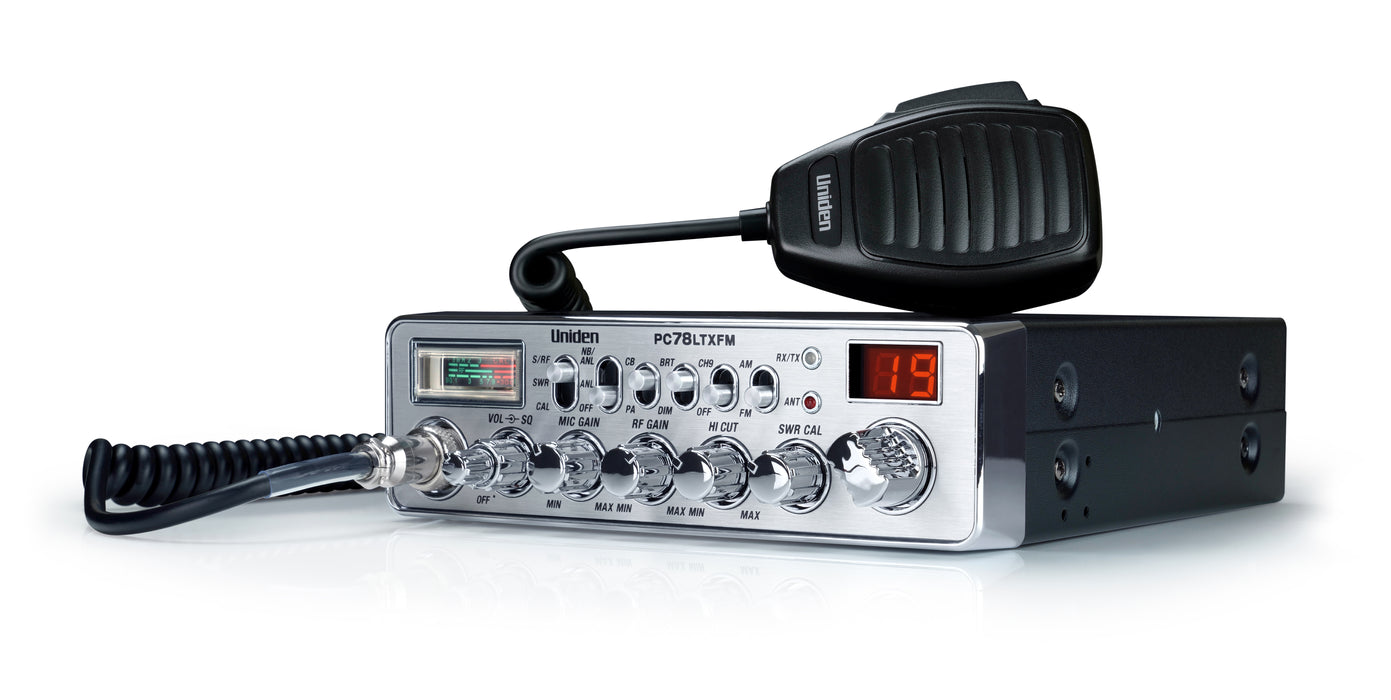Home>Devices & Equipment>Radio>What Does FM Stand For Radio


Radio
What Does FM Stand For Radio
Modified: January 22, 2024
Discover the meaning of FM in radio stations and broadcasting. Explore the acronym "FM" and its significance in the world of radio.
(Many of the links in this article redirect to a specific reviewed product. Your purchase of these products through affiliate links helps to generate commission for AudioLover.com, at no extra cost. Learn more)
Table of Contents
Introduction
When it comes to broadcasting, radio has been an integral part of our lives for decades. It has connected people through news, music, and entertainment, providing a constant source of information and enjoyment. One of the most popular formats of radio is FM. But what does FM stand for, and why is it so widely used?
FM stands for Frequency Modulation, a method of transmitting audio signals via radio waves. It offers superior sound quality and a more reliable signal compared to other radio frequencies. FM radio has revolutionized the way we listen to music and stay updated with the latest news and events.
In this article, we will delve into the fascinating world of FM radio, exploring its history, how it works, advantages, uses, frequencies, coverage, and the challenges it faces in the modern digital era.
So, if you’re curious about the technology behind FM radio and want to discover the role it plays in our lives, keep reading!
Definition of FM
In the realm of radio broadcasting, FM refers to Frequency Modulation. It is a method of transmitting audio signals through radio waves by varying the frequency of the carrier wave. Unlike AM (Amplitude Modulation), which modulates the amplitude of the carrier wave, FM focuses on altering the frequency. This modulation technique enables FM radio to provide a high-fidelity audio experience with minimal interference.
FM broadcast signals are transmitted within a specific frequency band, typically ranging from 87.5 to 108.0 MHz. The frequency modulation allows for a wider signal bandwidth, resulting in superior sound quality compared to AM radio. The modulation of the carrier wave corresponds to the audio signal’s changes in frequency, resulting in a more accurate representation of the original sound.
Furthermore, FM signals are less susceptible to noise and electromagnetic interference, making them ideal for high-quality audio transmission. These signals can cover a significant geographic area while maintaining a strong and clear reception in most locations.
FM radio has become a standard feature in most homes, cars, and portable devices. It offers a wide range of programming, including music, news, talk shows, sports broadcasts, and more. With advancements in technology, FM broadcasting has evolved to provide enhanced services like stereo sound, RDS (Radio Data System) for displaying song information, and HD Radio for improved audio quality.
In summary, FM, or Frequency Modulation, is a radio broadcasting method that modulates the frequency of the carrier wave to transmit audio signals. It delivers high-fidelity sound, excellent reception, and a diverse range of programming, making it an essential medium for entertainment, information, and communication.
History of FM Radio
The history of FM radio dates back to the early 20th century when inventors and innovators sought to improve the quality and range of radio transmissions. In the 1930s, engineer Edwin Armstrong made groundbreaking discoveries that paved the way for the development of Frequency Modulation.
Armstrong’s experiments and research led to the creation of FM radio as we know it today. In 1933, he obtained a patent for his FM system, which offered significant improvements over the existing AM (Amplitude Modulation) technology. FM allowed for a wider range of audio frequencies, reducing static and interference and providing clearer, more reliable sound transmission.
However, the path to establishing FM as the dominant radio format was not without obstacles. In the late 1930s and early 1940s, commercial interests backed AM radio and resisted the adoption of FM technology. The AM advocates feared that FM would render their investments in AM radio stations and equipment obsolete.
Nevertheless, Armstrong persisted in his efforts to promote FM radio. His dedication paid off when he successfully demonstrated the superior sound quality and noise reduction capabilities of FM transmissions during the National Association of Broadcasters (NAB) conference in 1940. This demonstration led to increased interest in FM and eventually led to the FCC (Federal Communications Commission) allocating broadcast bands for FM radio.
The popularity of FM radio grew steadily over the following decades. It gained widespread adoption in the 1970s and 1980s when stereo FM broadcasting became the industry standard. FM radio offered listeners a higher-quality audio experience, attracting more listeners and advertisers.
With the digital revolution, FM radio faced competition from new technologies such as satellite radio and internet streaming. However, FM radio has remained resilient, adapting to these challenges. It continues to play a significant role in broadcasting music, news, and other forms of entertainment in communities around the world.
Today, FM radio remains an important part of our daily lives, connecting us to our favorite music, talk shows, and current events. It continues to evolve with advancements like HD Radio and online streaming, ensuring that FM radio remains a vital medium of communication and entertainment well into the future.
How FM Radio Works
FM radio operates on the principle of frequency modulation, where the audio signal is encoded onto a radio wave by varying its frequency. Let’s take a closer look at how FM radio works:
- Audio Signal Source: The audio signal, such as music or speech, is picked up by a microphone or obtained from a sound recording. This analog audio signal carries the amplitude and frequency variations of the sound.
- Modulation: The audio signal is then fed into an electronic circuit called a modulator. The modulator combines the audio signal with a high-frequency carrier wave that serves as the carrier signal for transmission.
- Frequency Modulation: In frequency modulation, the carrier wave’s frequency is varied in response to the changes in the audio signal. The amplitude of the carrier wave remains constant. The modulated carrier wave contains the encoded audio information.
- RF Amplifier: The modulated signal is then amplified by an RF (Radio Frequency) amplifier to increase its strength.
- Antenna and Transmission: The amplified signal is sent to an antenna. The antenna radiates the signal as radio waves into the surrounding space, allowing it to travel long distances.
- Receiver and Demodulation: To receive and listen to FM radio, a receiver is needed. The receiver consists of an antenna to capture the FM radio waves and convert them back into electrical signals. The demodulator circuit within the receiver separates the audio information from the carrier wave by extracting the frequency variations imposed during modulation.
- Audio Amplification and Output: The demodulated audio signal is then amplified and sent to a speaker or headphones, where it is converted back into sound waves. This allows listeners to hear the original audio signal, whether it’s music, speech, or other forms of audio content.
With this process, FM radio delivers high-quality sound with minimal interference. The use of frequency modulation ensures that FM radio is less susceptible to noise and atmospheric disturbances. This makes FM radio an ideal choice for enjoying a wide variety of audio content, ranging from music and talk shows to news and sports broadcasts.
Advantages of FM Radio
FM radio offers a range of advantages that have contributed to its enduring popularity and widespread use. Let’s explore some of the key advantages of FM radio:
- Superior Sound Quality: FM radio provides high-fidelity sound reproduction, offering a richer and more immersive audio experience compared to other radio formats. The frequency modulation technique ensures that the audio signal remains clear and free from the interference often encountered in AM radio.
- Minimal Interference: FM radio is less susceptible to noise and electromagnetic interference, resulting in a consistent and uninterrupted listening experience. It allows for reliable reception, even in areas with obstacles or weak signals.
- Large Coverage Area: FM radio signals can cover a significant geographic area. FM stations have greater range and reach compared to AM stations, making FM radio accessible to more listeners. This wide coverage contributes to the popularity and accessibility of FM radio as a medium of communication and entertainment.
- Stereo Sound: FM radio introduced stereo broadcasting, allowing for a more immersive audio experience. With two separate audio channels, listeners can enjoy music, concerts, and broadcasts with enhanced depth and spatial realism.
- RDS (Radio Data System): FM radio stations often utilize RDS, which provides additional information to listeners on compatible radios. This information can include the station’s name, song titles, traffic updates, and more, enhancing the overall listening experience.
- Emergency Broadcasting: FM radio has proven to be a reliable medium for emergency broadcasting. During emergencies or natural disasters when power and internet services may be disrupted, FM radio continues to function, providing crucial information and updates to the affected communities.
- Energy Efficient: FM radio receivers require less power compared to devices that rely on internet streaming. This energy efficiency makes FM radio an environmentally friendly and sustainable option for accessing audio content.
These advantages make FM radio an attractive choice for both broadcasters and listeners alike. Whether it’s for enjoying music, staying informed with news and updates, or receiving emergency information, FM radio continues to serve as a reliable and versatile medium of communication and entertainment.
Uses of FM Radio
FM radio serves a wide range of purposes and has found applications in various areas of our lives. Let’s explore some of the primary uses of FM radio:
- Music and Entertainment: One of the primary uses of FM radio is to broadcast music and provide entertainment to listeners. FM radio stations cover various genres and styles, catering to diverse musical preferences. Listeners enjoy tuning in to their favorite stations to discover new music, stay updated with the latest releases, and enjoy live broadcasts of concerts and events.
- News and Information: FM radio plays a crucial role in delivering news and information to communities. News stations and talk shows provide up-to-date local, national, and international news, weather updates, traffic reports, and interviews with experts and celebrities. FM radio serves as a reliable source of information, keeping listeners informed and connected with the world.
- Talk Shows and Discussions: FM radio hosts a variety of talk shows and discussion programs on various topics, including politics, current events, lifestyle, health, and more. These programs encourage dialogue, debate, and community engagement, allowing listeners to participate by calling in and sharing their opinions.
- Sports Broadcasting: FM radio is a popular medium for sports enthusiasts. Stations broadcast live coverage of sports events, providing play-by-play commentary, analysis, and interviews. Whether it’s football, baseball, basketball, or other sports, FM radio allows fans to follow their favorite teams and stay connected to the action.
- Emergency Broadcasting: FM radio plays a vital role in emergency situations. During natural disasters, power outages, or other crises, FM radio remains operational, providing essential emergency alerts, updates, and instructions to the affected communities. The wide coverage and reliability of FM radio make it an invaluable tool for disseminating critical information.
- Community and Local Programming: FM radio often focuses on community-oriented programming, promoting local artists, events, and businesses. Community radio stations serve as platforms for local artists, grassroots movements, and cultural programs, fostering a sense of community and showcasing the diversity of local talent.
These are just some examples of the diverse uses of FM radio. From music and entertainment to news, talk shows, sports, emergencies, and community programming, FM radio remains a versatile medium that serves as a source of information, connection, and entertainment for listeners around the world.
FM Radio Frequencies
FM radio frequencies refer to the specific range of radio frequencies allocated for FM radio broadcasting. These frequencies allow FM radio stations to transmit their signals and reach listeners with their programming. In general, FM radio frequencies fall within the range of 87.5 to 108.0 MHz.
The use of specific frequency bands for FM radio is regulated by government agencies, such as the Federal Communications Commission (FCC) in the United States. These agencies allocate and assign frequency bands to ensure efficient use of the radio spectrum and prevent interference between radio stations.
FM radio frequencies are divided into channels, with each channel occupying a specific frequency within the designated FM band. The channels are typically spaced 200 kHz apart, ensuring that there is sufficient bandwidth for each station.
For example, in the United States, FM radio frequencies start at 87.9 MHz and progress in steps of 0.2 MHz. This means that the next FM frequency after 87.9 MHz would be 88.1 MHz, followed by 88.3 MHz, and so on. The highest frequency in the FM band is 108.0 MHz.
It’s worth noting that FM radio frequencies can vary between countries and regions due to different frequency allocation policies. It is also important for radio stations to adhere to the assigned frequencies and operate within the allowed power limits to avoid interference with other stations.
The FM radio frequencies provide broadcasters the opportunity to reach a wide range of listeners within their coverage area. Listeners can tune in to their favorite stations by dialing in the corresponding frequency on their FM radio receivers, enabling them to enjoy music, news, talk shows, and other content transmitted by FM radio stations.
Overall, FM radio frequencies form the backbone of FM radio broadcasting, allowing stations to transmit their content and connect with audiences through the airwaves.
FM Radio Coverage
FM radio coverage refers to the geographic area over which a particular FM radio station’s signal can be received with a satisfactory level of reception. FM radio signals can reach varying distances depending on several factors, including transmission power, antenna height, terrain, and environmental conditions.
The coverage area of an FM radio station is often referred to as its broadcast footprint. This footprint can range from a localized coverage in a small community to a regional, national, or even international reach, depending on the station’s capabilities and license.
The effective coverage of an FM radio station is influenced by the transmission power of the station. Higher transmission power allows signals to travel further, reaching listeners at greater distances from the station’s transmitter. However, transmission power alone is not the sole determinant of coverage. Other factors, such as antenna height and the presence of obstructions like buildings or natural terrain, also play a role in determining the range of an FM radio station’s coverage.
FM radio signals can be affected by environmental conditions, atmospheric interference, and topography. In hilly or mountainous regions, for example, FM signals can face challenges due to signal blockage or reflection caused by the landscape.
The coverage of an FM radio station can also be influenced by the usage of directional antennas. Directional antennas focus the radio waves in a specific direction, allowing stations to target their signals toward their intended coverage areas and minimize interference with neighboring stations.
It’s important to note that FM radio coverage is typically more localized compared to other forms of broadcasting, such as AM or satellite radio. FM signals are most effective within a radius of 40 to 60 miles from the transmitter on average, although some stations with high transmission power and favorable conditions may reach even further distances.
FM radio stations often employ a network of transmitters strategically placed throughout their coverage area to ensure adequate signal strength and reception. These transmitters, known as FM repeaters or translators, retransmit the main signal to reach areas that may be geographically challenging or outside the primary coverage of the main transmitter.
Overall, FM radio coverage varies depending on factors such as transmission power, antenna height, terrain, and environmental conditions. These factors, along with the station’s license and technical capabilities, determine the reach and effectiveness of an FM radio station’s broadcast footprint.
Challenges of FM Radio Broadcasting
While FM radio broadcasting has been a significant part of our lives for many years, it faces several challenges in the modern digital era. Let’s explore some of the key challenges that FM radio broadcasting encounters:
- Competition from Digital Platforms: FM radio faces fierce competition from digital platforms such as online streaming services, podcasts, and satellite radio. These platforms offer a wide range of options and convenience, allowing listeners to access personalized content on-demand. FM radio needs to adapt and innovate to stay relevant in the digital landscape.
- Internet Streaming: The rapid growth of internet streaming has provided listeners with an alternative to traditional radio. With the availability of high-speed internet and mobile devices, many people choose to stream music and audio content online. FM radio stations need to embrace streaming technologies to reach a broader audience and remain competitive.
- Signal Limitations: Despite its advantages, FM radio signals are limited in range. The signals can face challenges in hilly or mountainous regions, urban areas with tall buildings, and remote locations. This can result in signal blockage or weak reception for listeners, especially in fringe areas of coverage.
- Changing Listener Habits and Preferences: As technology evolves, so do listener habits and preferences. Younger generations, in particular, are adopting new media consumption habits, favoring digital platforms and personalized content. FM radio needs to understand these changing preferences and find ways to engage with younger audiences.
- Advertisement Revenue: FM radio heavily relies on advertising revenue to sustain operations. However, with the rise of digital advertising and alternative media platforms, competition for advertising dollars has intensified. FM radio faces the challenge of attracting advertisers, delivering targeted advertising solutions, and proving its value in the advertising landscape.
- Technological Advancements: While technology advancements have benefited FM radio in many ways, keeping up with the latest technologies can be a challenge. Upgrading infrastructure, investing in new equipment, and adopting digital broadcasting standards require considerable investments. FM radio stations need to continually evolve their technology to provide better quality and more efficient broadcasting.
Despite these challenges, FM radio continues to thrive due to its wide accessibility, reliable coverage, and inherent advantages. FM radio stations have the opportunity to leverage digital platforms, embrace streaming technologies, engage with audiences through social media, and deliver unique and compelling content to keep listeners engaged and connected.
By adapting to the changing media landscape, understanding listener preferences, and offering innovative programming, FM radio can overcome these challenges and remain an essential medium for entertainment, information, and community engagement.
Conclusion
FM radio, or Frequency Modulation radio, has played a significant role in our lives as a source of entertainment, information, and community connection for decades. From its inception to the present day, FM radio has undergone technological advancements and faced challenges in the ever-evolving media landscape.
With its superior sound quality, minimal interference, and wide coverage, FM radio continues to provide a high-fidelity audio experience for listeners. It has remained a reliable medium for accessing music, news, talk shows, sports broadcasts, and emergency information.
However, FM radio is not without its challenges. The rise of digital platforms, changing listener preferences, signal limitations, and the need to adapt to new technologies pose significant hurdles for FM radio broadcasting. To thrive in the digital era, FM radio must embrace streaming technologies, engage with younger audiences, and deliver engaging and innovative content.
Despite these challenges, FM radio has proven its resilience and adaptability over time. It remains a vital part of our daily lives, providing a sense of community, connection, and entertainment. FM radio stations can leverage their unique advantages, explore digital platforms, and embrace technological advancements to ensure their continued relevance and appeal.
As we look to the future, FM radio has the opportunity to evolve and expand its reach by embracing streaming, offering personalized content, and delivering an exceptional user experience. By staying attuned to listener preferences, investing in technology, and innovating their programming, FM radio can continue to be a beloved and indispensable medium of communication and entertainment.











